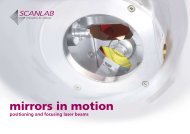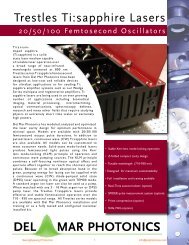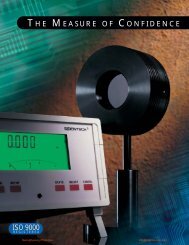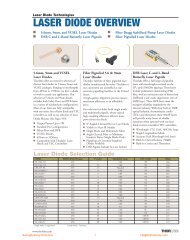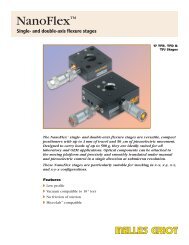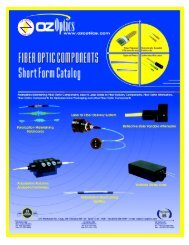DPSS Laser - 성경 포토닉스
DPSS Laser - 성경 포토닉스
DPSS Laser - 성경 포토닉스
- No tags were found...
You also want an ePaper? Increase the reach of your titles
YUMPU automatically turns print PDFs into web optimized ePapers that Google loves.
Light Emitting Diode TechnologiesRadiometric vs. Photometric UnitsFor many applications, light emitting diodes (LEDs) provide a low cost, reliable alternative to traditional light sources such as theincandescent light bulb, halogen bulbs, or arc lamps. Applications involving these former light sources gave rise to photometric measuresfor power, brightness, etc. Since Thorlabs typically provides radiometric specifications for our laser diodes, this overview is to serve as thebridge between the two regimes.Depending on the LED, the specifications might be given using any of the following radiometric quantities: power (also called radiantflux and measured in watts (W)), irradiance (measured in W/m 2 ), radiant intensity (measured in watts per steradian (W/sr)), and radiance(measured in W/m 2·sr). The corresponding photometric quantities, which are listed in the table below, are based on the SI unit forluminous intensity, the candela (cd). Values reported in candelas are weighted by a spectral luminous efficiency function, which representsthe human eye’s sensitivity to the light at a given wavelength. Hence, candelas are a photometric unit, thereby giving information aboutthe perceived brightness of a source; in contrast, power, irradiance, radiant intensity, and radiance are radiometric units, thus providinginformation about the absolute brightness of a source.Based on the candela, three other photometric quantities are also commonly used to specify power measurements for LEDs: luminance(measured in cd/m 2 , which is also sometimes referred to as a Nit), luminous flux (whose SI unit is the lumen (lm)), and illuminance(whose SI unit is the lux (lx)). Therefore, each radiometric quantity has a photometric counterpart, which is weighted by the spectralresponse of the human eye.To convert between radiometric and photometric units, one needs to know the photopic spectral luminous efficiency curve V(), whichgives the spectral response of the human eye to various wavelengths of light. The original curve, which is shown below, was adopted by theCommission on Illumination (CIE) as the standard in 1924 and is still used today even though modifications have been suggested.Empirical data shows that the curveQUANTITY RADIOMETRIC PHOTOMETRIC has a maximum value of unity atPower W Lumen (lm) = cd·sr 555nm, which is the wavelength oflight at which the human eye is mostPower Per Unit Area W/m 2 Lux (lx) = cd·sr/m 2 = lm/m 2sensitive, and trails off to levels belowPower Per Unit Solid Angle W/sr Candela (cd) 10 -5 for wavelengths below 370nmand above 780nm.Power Per Unit Area Per Unit Solid Angle W/m 2·sr cd/m 2 = lm/m 2·sr = nitNormalized Efficiency10.8Photopic Spectral Luminous Efficiency CurveA non-linear regression fit to the experimentaldata yields the approximation,V( λ ) = 1.019e2−285.4(λ −0.559)0.6where the wavelength is in micrometers.According to the definition for a candela, there0.4are 683 lumens per watt for 555nm light that ispropagating in a vacuum. Hence, for a0.2monochromatic light source, it is fairly simple toconvert from watts to lumens; simply multiply0the power in watts by the appropriate V() value,300 400 500 600 700 800 and use the conversion factor from the definitionWavelength (nm)for a candela.For example, the photometric power of a 5mW red ( = 650nm) laser pointer, which corresponds to V() = 0.096, is 0.096 x 0.005W x683lm/W = 0.33lm, whereas the value for a 5mW green ( = 532nm) laser pointer is 0.828 x 0.005W x 683lm/W = 2.83lm. Thus,although both laser pointers have the exact same radiant flux, the green laser pointer will appear approximately 8.5 times brighter thanthe red one assuming both have the same beam diameter.Conversion from radiometric to photometric units becomes more complex if the light source is not monochromatic. In this case, themathematical quantity of interest isΦ V= Kλ = 830m ∫ ΦEλ = 380( λ)V( λ)δλwhere v is the luminous flux in lumens, Km is a scaling factor equal to 683 lumens per watt, E () is the spectral power in watts pernanometer, and V() is the photopic spectral luminous efficiency function. Note that the integration is only carried out over thewavelengths for which V() is non-zero (i.e. = 380 - 830nm). Since V() is given by a table of empirical values, it is best to do theintegration numerically.06www.thorlabs.com<strong>성경</strong><strong>포토닉스</strong> 35 info@skphotonics,





